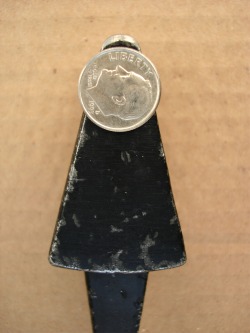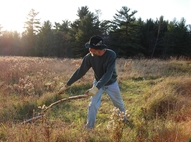 A narrow, or bar peen anvil, needs to have a rounded face. How rounded should it be? Preferences vary with peening techniques. The amount of roundedness is called the radius. Since all rounded narrow anvils are rounded off by hand (not cast), it's an approximation that can vary slightly between individual anvils, and considerably with entire batches from year to year. The amount of radius makes a huge difference in how the anvils peens, yet no one that sells scythe anvils ever describes it. I've been trying for years to think of a way of classifying the amount of radius on a narrow anvil. Measuring the radius in actual mm is hard to relate to unless you're an engineer. Also, I don't have a metric radius gauge, and haven't come up with one yet. Classifying the radius as narrow, medium, or wide seemed too vague and relative, without a method of measurement. So I thought of comparing the radius to a common standard sized object. The best thing that I could think of was a U.S. dime, which has a radius of 9mm. According to engineer Gerhard Wagner of the SFX factory, a radius of 9-12mm on a narrow anvil is classified as a "blunt" anvil. 6-8mm is a "normal" anvil, and 4-5mm is a "sharp" anvil. The Picard anvil pictured above, looks like it has a radius at the narrower side of the "normal" spectrum. The commonly available Czech-made "babbka's", are not rounded, but they are soft enough to shape a radius to your liking. Good luck doing that with the Picard, or the 60 Rockwell SFX anvil!
2 Comments
|
Botan AndersonArchives
March 2023
Categories
All
|

 RSS Feed
RSS Feed